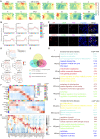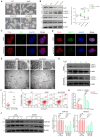Deciphering the autophagy regulatory network via single-cell transcriptome analysis reveals a requirement for autophagy homeostasis in spermatogenesis
- PMID: 33754041
- PMCID: PMC7978313
- DOI: 10.7150/thno.55645
Deciphering the autophagy regulatory network via single-cell transcriptome analysis reveals a requirement for autophagy homeostasis in spermatogenesis
Abstract
Background: Autophagy has been implicated as a crucial component in spermatogenesis, and autophagy dysfunction can lead to reproductive disorders in animal models, including yeast, C. elegans and mice. However, the sophisticated transcriptional networks of autophagic genes throughout human spermatogenesis and their biological significance remain largely uncharacterized. Methods: We profiled the transcriptional signatures of autophagy-related genes during human spermatogenesis by assessing specimens from nine fertile controls (including two normal persons and seven obstructive azoospermia (OA) patients) and one nonobstructive azoospermia (NOA) patient using single-cell RNA sequencing (scRNA-seq) analysis. Dysregulation of autophagy was confirmed in two additional NOA patients by immunofluorescence staining. Gene knockdown was used to identify the role of Cst3 in autophagy during spermatogenesis. Results: Our data uncovered a unique, global stage-specific enrichment of autophagy-related genes. Human-mouse comparison analysis revealed that the stage-specific expression pattern of autophagy-related genes was highly conserved in mammals. More importantly, dysregulation of some clusters of autophagy-related genes was observed in NOA patients, suggesting the association of autophagy with male infertility. Cst3, a human-mouse conserved and autophagy-related gene that is actively expressed in spermatogonia and early spermatocytes, was found to regulate spermatogonial stem cell (SSC) maintenance and subsequent male germ cell development. Knockdown of Cst3 increased autophagic activity in mouse SSCs and subsequently suppressed the transcription of SSC core factors such as Oct4, Id1, and Nanos3, which could be efficiently rescued by manipulating autophagic activity. Conclusions: Our study provides comprehensive insights into the global transcriptional signatures of autophagy-related genes and confirms the importance of autophagy homeostasis in SSC maintenance and normal spermatogenesis, opening new avenues for further dissecting the significance of the autophagy regulatory network in spermatogenesis as well as male infertility.
Keywords: autophagy; male infertility.; meiosis; single-cell RNA sequencing; spermatogenesis; spermatogonial stem cells.
© The author(s).
Conflict of interest statement
Competing Interests: The authors have declared that no competing interest exists.
Figures





Similar articles
-
scRNA-seq and scATAC-seq reveal that Sertoli cell mediates spermatogenesis disorders through stage-specific communications in non-obstructive azoospermia.Elife. 2025 May 15;13:RP97958. doi: 10.7554/eLife.97958. Elife. 2025. PMID: 40371706 Free PMC article.
-
Study on DNA Damage Gene in Spermatogonial Stem Cells from Idiopathic Nonobstructive Azoospermia: A Bioinformatics Investigation Based on scRNA-seq Data.Cytogenet Genome Res. 2025;165(1):9-22. doi: 10.1159/000545275. Epub 2025 Mar 18. Cytogenet Genome Res. 2025. PMID: 40101697
-
RNF144B stimulates the proliferation and inhibits the apoptosis of human spermatogonial stem cells via the FCER2/NOTCH2/HES1 pathway and its abnormality is associated with azoospermia.J Cell Physiol. 2022 Sep;237(9):3565-3577. doi: 10.1002/jcp.30813. Epub 2022 Jun 14. J Cell Physiol. 2022. PMID: 35699595
-
scRNA-Seq-Based Transcriptome Profiling and Relevant Bioinformatics Approaches to Uncover Novel Insights in Studying Human Spermatogenesis.Adv Exp Med Biol. 2025;1469:173-205. doi: 10.1007/978-3-031-82990-1_9. Adv Exp Med Biol. 2025. PMID: 40301258 Review.
-
Single-cell RNA sequencing technology in human spermatogenesis: Progresses and perspectives.Mol Cell Biochem. 2024 Aug;479(8):2017-2033. doi: 10.1007/s11010-023-04840-x. Epub 2023 Sep 2. Mol Cell Biochem. 2024. PMID: 37659974 Review.
Cited by
-
Molecular mechanisms of cellular dysfunction in testes from men with non-obstructive azoospermia.Nat Rev Urol. 2024 Feb;21(2):67-90. doi: 10.1038/s41585-023-00837-9. Epub 2023 Dec 18. Nat Rev Urol. 2024. PMID: 38110528 Review.
-
Autophagy mediated tubulobulbar complex components degradation is required for spermiation.Fundam Res. 2022 Oct 25;4(6):1557-1567. doi: 10.1016/j.fmre.2022.10.006. eCollection 2024 Nov. Fundam Res. 2022. PMID: 39734555 Free PMC article.
-
The chemical reprogramming of unipotent adult germ cells towards authentic pluripotency and de novo establishment of imprinting.Protein Cell. 2023 Jun 28;14(7):477-496. doi: 10.1093/procel/pwac044. Protein Cell. 2023. PMID: 36921016 Free PMC article.
-
Modulation of Atg genes expression in aged rat liver, brain, and kidney by caloric restriction analyzed via single-nucleus/cell RNA sequencing.Autophagy. 2023 Feb;19(2):706-715. doi: 10.1080/15548627.2022.2091903. Epub 2022 Jun 23. Autophagy. 2023. PMID: 35737739 Free PMC article.
-
An artificial neural network model to diagnose non-obstructive azoospermia based on RNA-binding protein-related genes.Aging (Albany NY). 2023 Apr 24;15(8):3120-3140. doi: 10.18632/aging.204674. Epub 2023 Apr 24. Aging (Albany NY). 2023. PMID: 37116198 Free PMC article.
References
-
- Zuccarello D, Ferlin A, Cazzadore C, Pepe A, Garolla A, Moretti A. et al. Mutations in dynein genes in patients affected by isolated non-syndromic asthenozoospermia. Hum Reprod. 2008;23:1957–62. - PubMed
-
- Heidary Z, Saliminejad K, Zaki-Dizaji M, Khorram Khorshid HR. Genetic aspects of idiopathic asthenozoospermia as a cause of male infertility. Hum Fertil (Camb) 2018. pp. 1–10. - PubMed
-
- Li L, Sha YW, Su ZY, Mei LB, Ji ZY, Zhang Q. et al. A novel mutation in HAUS7 results in severe oligozoospermia in two brothers. Gene. 2018;639:106–10. - PubMed
Publication types
MeSH terms
Substances
Supplementary concepts
LinkOut - more resources
Full Text Sources
Other Literature Sources
Molecular Biology Databases
Miscellaneous

